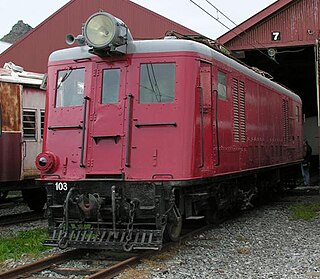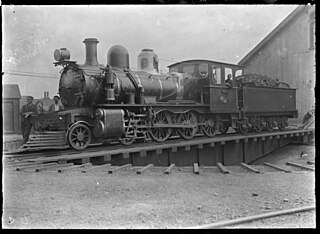
Railway preservation in New Zealand is the preservation of historically significant facets of New Zealand's rail transport history. The earliest recorded preservation attempt took place in 1925, although the movement itself did not start properly until 1960.

The Bealey River is a small river located in the Southern Alps of New Zealand. It is a tributary of the Waimakariri River. Its valley forms the eastern approach to Arthur's Pass. The river and the Bealey settlement are named for Samuel Bealey, a 19th-century Superintendent of Canterbury Province and pastoralist.

The New Zealand F class was the first important class of steam locomotive built to operate on New Zealand's railway network after the national gauge of 3 ft 6 in was adopted. The first locomotives built for the new gauge railways were two E class double Fairlies for the Dunedin and Port Chalmers Railway Company. The F class was the first class ordered by the central government, and between 1872 and 1888, a total of eighty-eight members of the class were constructed.

The Plains Vintage Railway & Historical Museum is a heritage railway and recreated historic village in the Tinwald Domain, Tinwald, New Zealand. The railway runs on approximately three kilometres of rural railway line that was once part of the Mount Somers Branch. The village and railway are open regularly to the public. The railway utilises preserved and restored locomotives and rolling stock once used on New Zealand's national railway network, while the village shows visitors how life was lived in New Zealand's pioneering past.

The NZR AB class was a class of 4-6-2 Pacific tender steam locomotive that operated on New Zealand's national railway system for New Zealand Railways (NZR). Originally an improvement on the 1906 A class, 141 were built between 1915 and 1927 by NZR's Addington Workshops, A & G Price of Thames, New Zealand, and North British Locomotive Company, making the AB class the largest class of steam locomotives ever to run in New Zealand. An additional eleven were rebuilt from the tank version of the AB – the WAB class – between 1947 and 1957. Two North British-made locomotives were lost in the wreck of the SS Wiltshire in May 1922.

The N class were 12 steam locomotives that operated on the national rail network of New Zealand. They were built in three batches, including one batch of two engines for the private Wellington and Manawatu Railway Company, the WMR, by the Baldwin Locomotive Works in 1885, 1891, and 1901. Previously the N class designation had been applied between 1877 and 1879 to Lady Mordaunt, a member of the B class of 1874.

The P class was a class of steam locomotives built to haul freight trains on the national rail network of New Zealand. The class consisted of ten individual locomotives ordered from the British company of Nasmyth, Wilson and Company in 1885, but miscommunications about the weight limitations imposed on the locomotives meant they did not start work until 1887. This debacle came at a time when the New Zealand Railways Department (NZR) was suffering from a lack of motive power to work on its rapidly expanding network and was part of what prompted a shift towards American and home-grown manufacturers.

The New Zealand E class locomotive comprised a single Mallet steam locomotive operated by New Zealand Railways (NZR) from 1906 until 1917. Classified as E 66 and nicknamed Pearson's Dream after its designer, it was an experimental Mallet locomotive designed to work on the Rimutaka Incline. The "E" classification was previously used by the Double Fairlie E class of 1872-75, but the classification was free as they had all been withdrawn by the time E 66 entered service. After the withdrawal of E 66, "E" was again re-used on the battery-electric E class of 1922. It was the only Mallet locomotive to operate for the NZR

The BC class comprised a single steam locomotive that operated on New Zealand's national rail network. Built for the Wellington and Manawatu Railway (WMR) and classified as No. 17, it passed into the ownership of the New Zealand Railways Department (NZR) when the government purchased the WMR in December 1908, and it was then that it acquired the BC classification as BC 463.

The NZR KA class of 1939 was a class of mixed traffic 4-8-4 steam locomotives that operated on New Zealand's railway network. They were built after the success of the K class to meet the increasing traffic demands of the New Zealand Railways Department. The locomotives first appeared with distinctive streamlining, mainly to hide their ACFI feedwater heater systems.

Steam Incorporated, often abbreviated to Steam Inc., is a railway heritage and preservation society based at the Paekākāriki railway station, Paekākāriki at the southern end of the Kāpiti Coast, approximately 50 minutes north of Wellington on the west coast of New Zealand's North Island. Unlike some societies who operate on preserved sections of closed branch lines, Steam Incorporated owns a depot beside one of the country's most important railway lines, the North Island Main Trunk railway, and restores heritage locomotives and rolling stock for use on excursions on the regular national rail network.

The NZR ED class locomotive was a type of electric locomotive used in Wellington, New Zealand. They were built by English Electric and the New Zealand Railways Department (NZR) between 1938 and 1940, and hauled mainly passenger trains on the Wellington region's 1500 V DC electrification, and banked freight trains on the steep section between Paekākāriki and Pukerua Bay.

The New Zealand V class steam locomotive was used on New Zealand's railway network from 1885 onwards. They were operated by New Zealand Government Railways and the Wellington and Manawatu Railway Company.

The Wellington and Manawatu Railway Company was a private railway company that built, owned and operated the Wellington-Manawatu railway line between Thorndon in Wellington, the capital of New Zealand, and Longburn, near Palmerston North in the Manawatu, between 1881 and 1908, when it was acquired by the New Zealand Government Railways. Its successful operation in private ownership was unusual for early railways in New Zealand.

The NZR WJ class was a class of one steam locomotive built by Baldwin Locomotive Works for service on New Zealand's private Wellington and Manawatu Railway (WMR). She acquired the WJ classification when the publicly owned New Zealand Railways Department (NZR) purchased the WMR and its locomotive fleet in 1908.

The NZR WH class was a class of three steam locomotives built by Manning Wardle in 1884 for service on New Zealand's private Wellington and Manawatu Railway Company (WMR). They did not acquire their WH classification until 1908 when WMR was nationalised and incorporated into the New Zealand Government Railways (NZR). A total of five locomotives were purchased by the WMR but two had been sold by the time NZR took over the company.

Branxholme locomotive dump is a steam locomotive and wagon dump located on the eastern bank of the Ōreti River adjacent and just to the north of Southland's Wairio Branch Line in New Zealand. Locomotives and rolling stock have been dumped here for river protection since the 1920s. In the time since numerous items have been recovered for preservation purposes.

The NZR U class, the first tender locomotives built in New Zealand, were a class of 4-6-0 Ten Wheeler locomotive designed to the requirements of Mr T. F. Rotherham and built at NZR Addington between 1894 and 1903. They were amongst NZRs' longest lived tender engines.

The NZR UC class were a group of ten 4-6-0 steam locomotives obtained from Scottish builders Sharp, Stewart and Company for New Zealand Railways (NZR). Essentially they were developments of the firm's previous batch of 4-6-0s' for NZR.

The North–South Junction is a section of single-track rail line about 7 km long, north of Wellington, New Zealand between the closed (2011) Muri railway station and the (lower) Paekakariki railway station to the north. It is part of the Kapiti Line section of the North Island Main Trunk line between Wellington and Auckland, and part of the Wellington–Manawatu Line, built by the Wellington & Manawatu Railway Company (WMR).




















